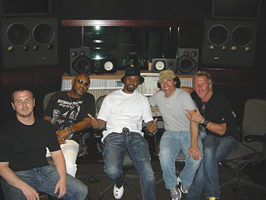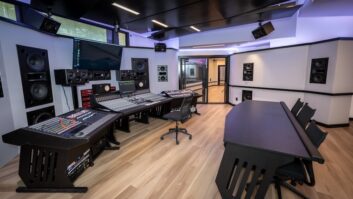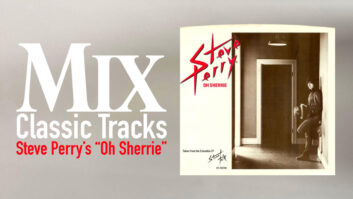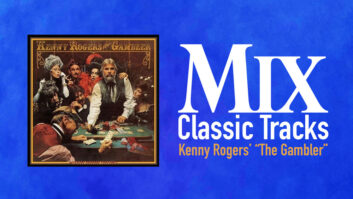
From left: Jason Fleming, Dom Trenier, Teddy Riley, John Oates and Jed Leiber at NightBird Studio, situated in the Sunset Marquis Hotel
During the 1970s and ’80s, I made frequent visits to the Sunset Marquis, a high-end but unpretentious hotel tucked away on Alta Loma, a side street a block west of La Cienega just below the Sunset Strip. The Tubes stayed there during one of their recording projects during their years at A&M, and as their product manager I had an excuse to hang out with the band in and around the courtyard pool. (What transpired in the rooms is none of your business.) My wife (who also worked at A&M) and I got our first taste of The Police’s second album, Regatta de Blanc, in Ian Copeland’s suite, and during the ’80s I interviewed hotel guests like Michael Hutchence of INXS and Robert Palmer, who autographed the albums I’d remembered to bring with me. A few years later, I got my first glimpse of the Sunset Marquis villas while interviewing Grace Slick on a grassy hillside. Early on, I decided that if I were a visitor to L.A., this was where I’d choose to stay.
Now, as in the old days, when you walk through the lobby and into the courtyard, with diners at its patio restaurant noshing and conversing in civilized murmurs under umbrellas, the bustle of L.A. is instantly replaced by a quietude approaching serenity. It’s hardly surprising that the hotel is favored by showbiz people who prefer to keep a discreetly low profile, in marked contrast to the nearby Chateau Marmont, with its see-and-be-seen vibe. But there have been some changes to the Sunset Marquis — changes in some ways indicative of the particular needs of the clientele. The recently expanded villas boast underground parking big enough for tour buses. And if an artist needs to do some overdubs or mixes in a top-of-the-line recording facility, there’s just that — a floor below the lobby area on the parking level, though you’d never know it was there. I certainly didn’t until a few months ago.
The idea for NightBird Studios — renamed on its 15th anniversary from its unwieldy original moniker, the Studio at Sunset Marquis Hotel & Villas — was hatched by keyboardist/producer/songwriter Jed Leiber as a joint venture with the hotel’s owners. The event that led to its genesis falls into the grand tradition of L.A. rock ‘n’ roll hotel stories, as close to Led Zeppelin’s TV-off-the-balcony episode at the old Continental Hyatt House on Sunset as this laid-back hotel is likely to get.
It went down in the wee hours of the morning in 1993, when New Yorker Leiber and his pal Jeff Beck were jamming in the guitarist’s Sunset Marquis suite, only to be interrupted by a knock on the door. It was Sunset Marquis general manager Rod Gruendyke, who expressed concern about nearby hotel guests who were trying to sleep. “Sleep?” Leiber said incredulously. “They should be slipping money under the door.” Gruendyke suggested that they take their axes down to the underground garage, which they did. They wound up at the present location of Studio A, which George Augspurger had built for New England Digital as a projected sales room for Synclaviers. Leiber jokes that he’s been down there ever since. He carted all his gear out from New York and gradually expanded the studio from its humble beginnings next to the laundry room to its present snazzy state. It’s now snazzy enough for Madonna, who very quietly spent three months here working on Hard Candy.
I take the elevator down from the lobby, step out into the parking garage and notice a row of heavy doors across the front wall. Out of the one on the far-right pops studio manager Lisa Yastic, who shows me around the compound. To the far-left is Studio B, which is currently being occupied by New Jack Swing pioneer Teddy Riley, who brought John Legend down two days earlier. Next door is a smaller workstation where staff engineer Steve Sundholm (son of the creator of Sunn Amps) spends a lot of his time. The adjacent A room, which is primarily used for recording, is dominated by a recently-arrived Yamaha 9-foot Concert Grand Pro/Mark IV Disklavier. All three spaces are dark and cocoon-like, thanks to muted lighting and mahogany wall coverings.
Yastic leads me into the main control room, where Leiber is huddled with John Oates, and staff engineers Sundholm and Jason Fleming. They’re just days away from completing the mix of Oates’ rootsy, all-star-laden solo project, 1,000 Miles of Life, which Leiber co-produced in Nashville’s Ronnie’s Place with the artist; he also played keys on eight of the 10 tracks. The room, its walls finished in mahogany, boasts a Digidesign ICON HD running Pro Tools HD6, with racks of vintage outboard gear to its right. Covering the front wall is a 120-inch projection screen, winged by Tannoy monitors. A half-dozen HD LCDs measuring up to 65 inches line the side walls. The dark-leather sofa on which Oates is seated stretches across the back of the room.
“John brings his Philly soul roots to the table; there’s the pop sensibility he’s known for, but there’s also all of these wonderful new elements,” Leiber says of the project. “The combination creates something I really haven’t heard before. From the beginning, John said, ‘I trust you, but please, I want this to be warm and natural.’ We accomplished that in tracking — it was recorded by the amazing Nashville engineer Bil VornDick — and we took that concept into the mix, running the tracks through analog gear to warm them up.”
Sundholm picks up the thread. “The basic signal chain,” he explains, “was the 1081, which is on everything, 1176, LA-2A, Vari-Mu, GML EQ. It’s classic music, and it called for classic vintage gear.”
The album was largely recorded live off the floor, and Oates was intent on retaining the sense of musicians interlocking in the moment. “I had this brand-new, $200,000 9-foot grand that I couldn’t wait to play and replace all my parts,” says Leiber. “And behind my back, John has my guys put a sign on the piano that says, ‘Jed is not allowed to play this piano until the mix is completed.’”
Oates is in the midst of a busy week, which started two days earlier when he and Daryl Hall received the BMI Icon Award and culminates with the duo’s two-night stand at the Troubadour. He’s staying at the hotel, of course.
The first stage of a major remodel visualized by Leiber was completed in January. “We had a very high-tech room,” says Leiber of the studio’s previous décor, “and having spent a fair amount of time in John’s studio in Aspen, I wanted something cozier. Plans are being drawn up for further expansion, including an enclosed lobby area. On order is a 72-channel SSL Duality to go in the main room because a number of producers who use the facility have expressed the desire to work on a traditional console. When the SSL arrives, the ICON will be moved to Studio B.
After touring the studio, I head up to the patio dining area with Yastic and Fleming. Sitting at the next table is David Cook, who had won American Idol the night before, enjoying a quiet moment during the busiest day of his life. Lisa, Jason and I all opt for the steak sandwich, which Sundholm had assured us was one of the five best he’d ever eaten. I hereby second that emotion.
Send L.A. news to Bud Scoppa:
bs7777@aol.com.






